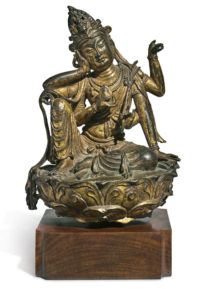 A gilded bronze figure of a Buddhist deity that was bought at a garage sale in Kirkwood, Missouri two decades ago for less than 100 bucks sold at auction Wednesday for $2.1 million.
A gilded bronze figure of a Buddhist deity that was bought at a garage sale in Kirkwood, Missouri two decades ago for less than 100 bucks sold at auction Wednesday for $2.1 million.
The deity depicted in the statuette is Avalokiteshvara, also known as Guanyin among many other appellations and forms. One of those forms, Cintamanicakra, is traditionally depicted holding the wish-granting jewel cintamani in front of his chest as he is here. He sits in the royal rajalilasana posture, his head resting on one of his three right hands. His elaborate updo is embraced by a high diadem trailing long ribbons. He wears beaded necklaces and his chest is crossed by draped and knotted robes. He holds a lotus stem in a left hand at the hip and the dharma wheel in a raised palm. A mala (a string of beads used in meditation) is in another hand. His sixth hand supports the body, planted on the lotus-form seat.
The seller brought the piece to Antiques Roadshow in St. Louis two years ago to find out what it was and how much it was worth.
“I almost didn’t have a chance to acquire it, because I was having 15 people for lunch,” she told appraiser Robert Waterhouse on the show. “There was a local person who was a colorful character in Kirkwood, so I really wanted to get to his garage sale (so) I rushed out.”
She added that she paid “probably between $75 and $100, which was a lot for me. It was about 20 years ago.” […]
Local antiques dealers completely missed the hidden gem in the sale, the owner told “Antiques Roadshow.” “The dealers had been there for two days before, so I thought everything good would be gone,” she said. The figurine had lost almost all its gilt and was missing an arm, “I thought it was so beautiful, I just grabbed it… I didn’t mind the damage.”
She was shocked when Waterhouse told her the gilt-bronze figurine was of such high quality that it was likely of imperial provenance. His conservative estimate for a retail price was $100,000–125,000. He thought it might date to the 15th century Ming Dynasty. Later researcher put the date far further back to the late Tang Dynasty (618-907 A.D.) or early (907-979 A.D.) Five Dynasties and Ten Kingdoms period and.
Sotheby’s auction estimate was even more conservative than Waterhouse’s at $60,000-80,000, but with the market for Chinese antiquities being molten hot, I suspect there was little doubt the piece would far exceed the estimate. Indeed, bidding was fierce and fast, driving the price into the millions. Seven minutes later, the hammer fell at $2,060,000.
I am glad you got the gender of Avalokiteshvara, also known as Guanyin correct. How the “pretty boy” Guanyin ever became the “Goddess of Mercy” is a mystery to me.
Myself, I know nothing, but the reincarnation of different local deities into ‘something else’, e.g. Mars, a church dedicated to Mary, or maybe one of the Bodhisattvas, was actually quite common. Thus, there might have been a local Chinese female deity:
————
“In Chinese Buddhism, Avalokiteśvara has evolved into the somewhat different female figure Guanyin. In Japan this figure is known as Kanzeon or Kannon“.
————
The Crossover Iconography is certainly interesting: Here, a ‘Chinese’ face combined with all those arms that seem kind of ‘Hindu’ to my completely unskilled eye. There had e.g. been even Hellenistic influences.
——–
P.S.: A relative of mine owns a wooden statue. The thing is roughly half a meter in size, looks really old, but it is of the ‘Fat Yogi’ type.
Avalokiteshvara, Guanyin or Kannon images are based on Tang Period representations. Kannon the Granter of Sons became a Madonna figure for Crypt-Chritians during the persecutions following the Japanese expulsion of the Spanish and Portuguese.
The story of how an ancient piece like this ended up at the garage sale seems like it would be interesting, I wonder if its provenance will ever be traced.